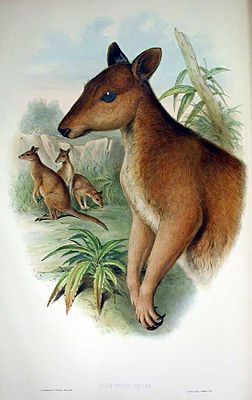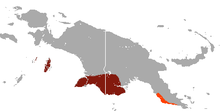Southern New Guinea filander
| Southern New Guinea filander | ||||||||||||
|---|---|---|---|---|---|---|---|---|---|---|---|---|

Thylogale brunii , drawing by John Gould |
||||||||||||
| Systematics | ||||||||||||
|
||||||||||||
| Scientific name | ||||||||||||
| Thylogale brunii | ||||||||||||
| ( Schreber , 1778) |
The southern New Guinea filander ( Thylogale brunii ) is a species of kangaroo from the genus Filander ( Thylogale ). Together with Thylogale browni , Thylogale calabyi and Thylogale lanatus , it used to be grouped together as New Guinea Filander .
These animals are relatively small representatives of the kangaroos with a stocky build. As with most kangaroos, the hind legs are significantly longer than the front legs, the tail is relatively short and sparsely hairy. The fur is colored a dark gray-brown, the underside is clearly lighter. There are white stripes on the face and hips.
The southern New Guinea filander lives in the south of the island of New Guinea and on the offshore Kai Islands and Aru Islands , but the populations on these islands are possibly due to human settlements. The species used to be found in south-eastern New Guinea, in the region around Port Moresby , but the population there has died out. The habitat of these animals are predominantly rainforests and rainforest- savannah mixed areas.
Little is known about the way these animals live. They are nocturnal and sleep hidden in the thick undergrowth during the day. At night they go in search of food, often on grassy areas near the edge of the forest. They are herbivores that eat grass and leaves.
In some areas, the southern New Guinea filander is heavily hunted with dogs for its meat. This hunt led to the disappearance of the animals from southeastern New Guinea, and the populations are also declining elsewhere. The IUCN estimates that the total population will decline by 30% in the next 15 to 20 years and lists the species as "endangered" ( vulnerable ).
In Europe the species is cultivated in Magdeburg, Antwerp, Paris, Pilsen and Sandwich.
literature
- Ronald M. Nowak: Walker's Mammals of the World. 6th edition. Johns Hopkins University Press, Baltimore 1999, ISBN 0-8018-5789-9 .
- DE Wilson, DM Reeder: Mammal Species of the World. Johns Hopkins University Press, Baltimore 2005. ISBN 0-8018-8221-4
supporting documents
Web links
- Thylogale brunii inthe IUCN Red List of Endangered Species . Retrieved May 19, 2009.
